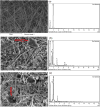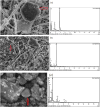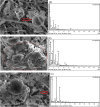On the Morphology and Composition of Particulate Matter in an Urban Environment
- PMID: 30344547
- PMCID: PMC6192059
- DOI: 10.4209/aaqr.2017.09.0340
On the Morphology and Composition of Particulate Matter in an Urban Environment
Abstract
Particulate matter (PM) plays a vital role in altering air quality, human health, and climate change. There are sparse data relevant to PM characteristics in urban environments of the Middle East, including Peshawar city in Pakistan. This work reports on the morphology and composition of PM in two size fractions (PM2.5 and PM10) during November 2016 in Peshawar. The 24 hous mass concentration of PM2.5 varied from 72 μg m-3 to 500 μg m-3 with an average value of 286 μg m-3. The 24 hours PM10 concentration varied from 300 μg m-3 to 1440 μg m-3 with an average of 638 μg m-3. The morphology, size, and elemental composition of PM were measured using Fourier Transform Infra Red (FT-IR) Spectroscopy and Scanning Electron Microscopy (SEM) with Energy Dispersive X-ray (EDX) Spectroscopy. The size of the analyzed particles by EDX ranged from 916 nm to 22 μm. Particles were classified into the following groups based on their elemental composition and morphology: silica (12%), aluminosilicates (23%), calcium rich (3%), chloride (2%), Fe/Ti oxides (3%), carbonaceous (49%), sulfate (5%), biogenic (3%). The major identified sources of PM are vehicular emissions, biomass burning, soil and re-suspended road dust, biological emissions, and construction activities in and around the vicinity of the sampling site.
Keywords: Energy Dispersive X-ray; Fourier Transform Infra Red Spectroscopy; Morphology and elemental composition; Particulate matter; Scanning Electron Microscopy.
Figures












Similar articles
-
Morphological, Mineralogical, and Biochemical Characteristics of Particulate Matter in Three Size Fractions (PM10, PM2.5, and PM1) in the Urban Environment.ACS Omega. 2023 Aug 25;8(35):31661-31674. doi: 10.1021/acsomega.3c01667. eCollection 2023 Sep 5. ACS Omega. 2023. PMID: 37692244 Free PMC article.
-
Assessment of annual air pollution levels with PM1, PM2.5, PM10 and associated heavy metals in Algiers, Algeria.Environ Pollut. 2018 Jan;232:252-263. doi: 10.1016/j.envpol.2017.09.041. Epub 2017 Sep 21. Environ Pollut. 2018. PMID: 28943349
-
In-depth characterization of particulate matter in a highly polluted urban environment at the foothills of Himalaya-Karakorum Region.Environ Sci Pollut Res Int. 2024 May;31(24):35705-35726. doi: 10.1007/s11356-024-33487-4. Epub 2024 May 13. Environ Sci Pollut Res Int. 2024. PMID: 38739339
-
Temporal variations of fine and coarse particulate matter sources in Jeddah, Saudi Arabia.J Air Waste Manag Assoc. 2018 Feb;68(2):123-138. doi: 10.1080/10962247.2017.1344158. Epub 2018 Jan 16. J Air Waste Manag Assoc. 2018. PMID: 28635552 Free PMC article.
-
Mass, composition, and sources of particulate matter in residential and traffic sites of an urban environment.Environ Geochem Health. 2023 May;45(5):2031-2050. doi: 10.1007/s10653-022-01327-4. Epub 2022 Jun 30. Environ Geochem Health. 2023. PMID: 35771398
Cited by
-
Nanostructured Bioaerogels as a Potential Solution for Particulate Matter Pollution.Gels. 2023 Jul 14;9(7):575. doi: 10.3390/gels9070575. Gels. 2023. PMID: 37504454 Free PMC article. Review.
-
Impact of PM2.5 Exposure from Wood Combustion on Reproductive Health: Implications for Fertility, Ovarian Function, and Fetal Development.Toxics. 2025 Mar 24;13(4):238. doi: 10.3390/toxics13040238. Toxics. 2025. PMID: 40278554 Free PMC article.
-
Foliar image-based characterization of airborne particulate matter in an urban area and its implications for remediation.Sci Rep. 2025 Jan 17;15(1):2212. doi: 10.1038/s41598-024-84552-4. Sci Rep. 2025. PMID: 39820289 Free PMC article.
-
Wintertime investigation of PM10 concentrations, sources, and relationship with different meteorological parameters.Sci Rep. 2024 Jan 2;14(1):154. doi: 10.1038/s41598-023-49714-w. Sci Rep. 2024. PMID: 38167892 Free PMC article.
-
Composition and source apportionment of saccharides in aerosol particles from an agro-industrial zone in the Indo-Gangetic Plain.Environ Sci Pollut Res Int. 2020 Apr;27(12):14124-14137. doi: 10.1007/s11356-020-07905-2. Epub 2020 Feb 10. Environ Sci Pollut Res Int. 2020. PMID: 32043252
References
-
- Adachi K, Chung SH, Buseck PR. Shapes of soot aerosol particles and implications for their effects on climate. J Geophys Res. 2010;115:D15206.
-
- Alam K, Blaschke T, Madl P, Mukhtar A, Hussain M, Trautmann T, Rahman S. Aerosol size distribution and mass concentration measurements in various cities of Pakistan. J Environ Monit. 2011;13:1944–1952. - PubMed
-
- Alam K, Rahman N, Khan HU, Haq BS, Rahman S. Particulate matter and its source apportionment in Peshawar, Northern Pakistan. Aerosol Air Qual Res. 2015;15:634–647.
-
- Alexander DTL, Crozier PA, Anderson JR. Brown carbon spheres in east Asian outflow and their optical properties. Science. 2008;321:833–836. - PubMed
-
- Allen DT, Palen EJ, Haimov MI, Hering SV, Young JR. Fourier transform infrared spectroscopy of aerosol collected in a low pressure impactor (LPI/FTIR): Method development and field calibration. Aerosol Sci Technol. 1994;21:325–342.
Grants and funding
LinkOut - more resources
Full Text Sources
